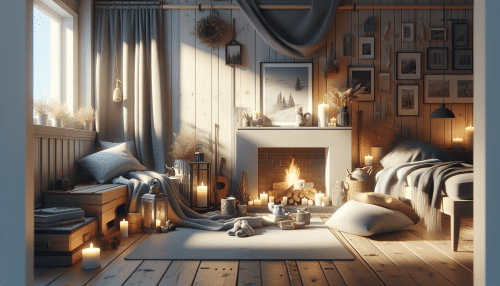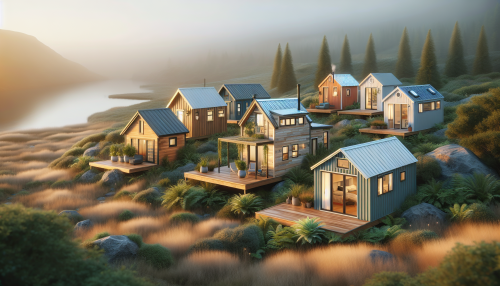Hidden Home Decor Trends You Won’t Want to Miss
Olivia Morgan November 1, 2025
Discover fresh inspiration for your living space as unseen home decor trends take over. In this guide, explore unique interior ideas, sustainable styling, and simple refresh tips to revitalize any room and boost your everyday comfort.
Why New Home Decor Trends Matter for Everyday Life
Home decor trends hold more than just visual appeal; they influence the atmosphere and mood of your living environment. Staying aware of emerging trends such as biophilic design and sustainable interiors offers the opportunity to refresh surroundings while supporting well-being. Subtle changes—from color palettes to texture blending—can subtly impact how people feel at home, creating spaces that sparkle with personality and function. The rise of mindful design shows that trends do not simply follow aesthetics but also emphasize comfort and flexibility for day-to-day life.
Behind every trend is a reflection of wider societal changes. For instance, the expansion of multipurpose rooms and flexible furnishings has grown in response to more time spent at home. Open shelving, natural elements, and calm hues respond to the need for serenity and organization. These decor decisions often help balance the demands of modern, bustling lifestyles while making rooms feel larger and more welcoming. This evolution means today’s trends are about crafting real-life comfort instead of show-home perfection.
Following new looks provides creative outlets and allows homeowners and renters alike to express themselves. Even the subtle adoption of trending wallpaper or a fresh accent chair can add new vibrancy. The joy of exploring hidden patterns, artisanal crafts, and international influences inspires ongoing curiosity about what’s possible. Trends ultimately empower people to make their spaces not only visually appealing but also personally satisfying and up to date with innovative ideas making life at home more enriching.
Eco-Friendly and Sustainable Decor Ideas Gaining Popularity
Eco-friendly decor has become a powerful force in interior design. Homeowners now seek options like recycled materials, upcycled furniture, and low-VOC finishes as part of their room updates. This growing consciousness about the environmental impact of home design leads to selections that promote a healthier home and a smaller ecological footprint. Reclaimed wood, bamboo textiles, and secondhand finds are shaping the narrative for creative, sustainable living spaces that stand out from traditional decor choices.
Sustainable style doesn’t mean sacrificing luxury or individuality. Designers are experimenting with organic shapes and earthy colors, resulting in cozy yet sophisticated environments. Greenery plays a pivotal role, with plants, moss walls, and natural fibers breathing life into every corner. Energy-efficient lighting, durable woven rugs, and multi-use decor pieces ensure that function and style work in harmony for the eco-conscious homeowner. The movement extends to timeless pieces built to last, creating homes with stories instead of short-lived trends.
Small changes can add up. Repurposing objects, supporting local craftspeople, and opting for natural finishes all contribute to an evolving green ethos. Even accessories like recycled glass vases or solar-powered lanterns provide entry points into a more climate-friendly interior. Eco-friendly design is no longer niche—it’s quickly becoming standard practice for those who want their living environment to reflect their values while maintaining a sense of elegance and comfort.
Color Palettes and Materials Dominating Hidden Trends
The current wave of trending colors leans towards soft earth tones, cheerful pastels, and expressive jewel hues. These colors evoke emotion, promote relaxation, or energize spaces according to personal preference. The comeback of warm beige, sage green, and terra cotta signals a desire for tranquility and authenticity. On the other hand, accents in bold blue or mustard yellow bring just the right dose of playfulness without overwhelming a room. Layered neutrals and statement walls are subtle yet compelling ways to embrace ongoing color revolutions.
Material choices are just as impactful. As people seek both comfort and sustainability, furniture and accessories made from rattan, cork, and jute become more sought after. Texture takes center stage, with velvet throws, boucle chairs, and handwoven baskets offering tactile delight. Mixed metals, once seen as clashing, now create dynamic visual interest—think matte brass with brushed black or polished chrome. The result is a home that is both comfortable and sophisticated, connected to nature and curated for daily living.
Combining colors, materials, and finishes can transform the most basic spaces. A seemingly simple tweak—a deep green wall, a chunky knit throw, or terrazzo tiles—can quietly anchor a room in today’s hidden trends. These small shifts allow individuals to update their style gradually, experiment with fresh ideas, and ultimately build interiors that balance classic touches with the excitement of the new.
Tapping Into Minimalism, Maximalism, and Personalized Spaces
Minimalism is not about empty rooms but about intentional choices. In many home settings, people embrace clutter-free spaces by selecting fewer, higher-quality pieces. Neutral tones, sleek storage, and clean lines make homes feel more open and organized. At the same time, subtle layers—like a textured rug or statement lighting—add warmth and prevent minimalism from feeling stark. This less-is-more approach helps reduce stress, making it easier to relax after a long day.
On the flip side, maximalist ideas are taking hold as many discover the joy in mixing patterns, colors, and treasures from different eras. Maximalism does not simply mean crowding rooms; rather, it’s about curation. Favorite artwork, travel finds, and vintage collectibles come together in bold combinations. Vibrant wallpaper, gallery walls, and layered patterns show off unique personalities. By balancing maximalist touches with restful elements, interiors become deeply personalized and visually exciting without feeling chaotic.
Many decorators now blend both approaches to find what suits them best. Some areas may lean minimalist, such as a tranquil bedroom, while others infuse maximalist flair, like an eclectic living room. Customization is key—modular shelves, tailored curtains, or custom woodwork enable unique spaces. Trends increasingly encourage mixing and matching, giving everyone the freedom to reimagine their home as their tastes evolve.
Quick Refreshes and Easy Upgrades on a Budget
Transforming a space does not always require a complete overhaul. Micro-trends like peel-and-stick wallpaper, removable wall decals, or affordable area rugs offer quick impacts. Simple swaps, such as changing pillow covers or updating hardware on cabinets, can rejuvenate any room without major investments. For those inspired by DIY, painting furniture or crafting new wall art breathes fresh life into tired spaces, keeping changes accessible and enjoyable.
Lighting is another powerful, often overlooked, tool for affordable updates. Swapping out lampshades, adding a dimmer, or introducing LED strip lights can shift the mood instantly. Experimenting with smart bulbs allows for custom settings, making homes multi-functional for work, relaxation, or entertainment. Even inexpensive changes like layering different light sources build ambiance and highlight anticipated trends in wellness-centered decor.
Lastly, consider the five-sense approach. Scented candles, fluffy mats, and soothing music zones can be as transformative as any visual update. Organizing open shelving, decluttering countertops, or even employing decorative baskets introduces functional style. Small, creative bursts—whether seasonal or spontaneous—turn everyday living into an ever-refreshing canvas. Hidden decor trends offer endless ideas for stylish, budget-friendly transformations adaptable for any lifestyle.
The Role of Technology and Smart Home Integration
The line between design and technology is fading fast. Smart home devices now appear in almost every room, blending efficiency with contemporary style. Voice-controlled assistants, integrated lighting, and remote climate controls support lifestyles looking for both comfort and modernity. Concealed charging stations and sleek speakers show that technology need not detract from aesthetics, often becoming a seamless part of the decor.
As more home dwellers seek multifunctionality, technology-driven furniture emerges—think sofas with built-in chargers or tables that double as workspaces. Virtual personalisation apps help preview decor updates before committing, making decorating decisions less risky and more engaging. With security systems, automated shades, and connected appliances part of the new normal, the smart home is less about gadgets and more about weaving convenience into everyday routines.
The beauty of current tech trends is their flexibility—they suit both renters and owners looking for scalable improvements. Innovations focus on discretion; wall-mounted devices, framework-integrated screens, and bespoke controls prioritize an uncluttered look. Blending smart living with style ensures that homes evolve as quickly as lifestyles—and keeps the process inspiring, manageable, and personalized for every taste and need.
References
1. American Society of Interior Designers. (n.d.). Home design trends survey. Retrieved from https://www.asid.org/resources/research/home-design-trends-survey
2. Houzz. (n.d.). 2023 home design predictions. Retrieved from https://www.houzz.com/magazine/2023-home-design-predictions-stsetivw-vs~157226988
3. National Association of Home Builders. (n.d.). Sustainability in home design. Retrieved from https://www.nahb.org/news-and-economics/industry-news/press-releases/2023/10/green-trends-in-residential-design
4. The Spruce. (n.d.). Interior design trends for 2023. Retrieved from https://www.thespruce.com/interior-design-trends-2023-7484264
5. Green Building Solutions. (n.d.). The importance of sustainable design. Retrieved from https://www.greenbuildingsolutions.org/importance-sustainable-design
6. Architectural Digest. (n.d.). How tech is transforming home design. Retrieved from https://www.architecturaldigest.com/story/how-tech-is-transforming-home-design





